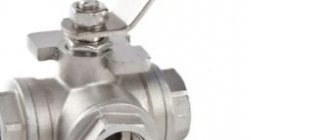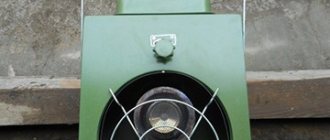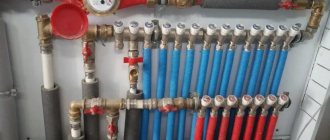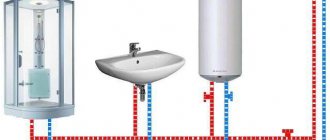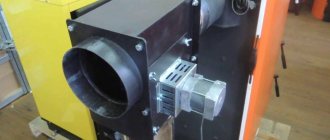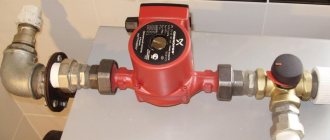Hello, dear readers of the site. Tubular electric heaters ( TEH ) are designed to convert electrical energy into heat. They are used as a basis
in heating devices (devices) for industrial and domestic use that heat various media by convection, thermal conductivity or radiation. Tubular heaters can be placed directly in the heated environment, so their scope of application is quite diverse: from irons and kettles to furnaces and reactors.
Electric heating element device
The design of heating elements includes the following components:
- metal tube;
- spiral;
- filler;
- ceramic insulator;
- contact rod.
The spiral is completely sealed in a metal tube and connected to a contact rod, the outer edge of which has the necessary projections for connection with the element that supplies the electric current. This design of heating elements eliminates the possibility of short circuits and ensures uniform distribution of heat over the entire surface of the metal tube.
The insulating filler of the spiral from the heating element tube is periclase, a mineral consisting of magnesium oxide sometimes with admixtures of iron oxide, manganese oxide and zinc oxide.
The metal tube of the heater is made of alloys:
- pure brass (Fig. 1) and copper (Fig. 2). These heating element tube materials are necessarily used with coatings;
- become. The steel can be either stainless (Fig. 3) or carbon (Fig. 4), it depends on the design features and operation of the heating element;
- aluminum (Fig. 5)
It can have different diameters, from 6 to 19 mm. The design of the block heating element can be equipped with a temperature sensor and an overheating fuse.
The choice of metals and their alloys depends on the working environment of the heating element. These can be alkalis and acids, air with low and high concentrations of active gases, various metal surfaces that will come into contact with the heating element, fatty compounds and aqueous solutions.
A conductive fechral or nichrome spiral acts as a heating element. Fechral spiral is an iron alloy with additions of copper, manganese, aluminum, titanium and other metals. The main advantages of a spiral made of fechral or its varieties (eurofechral, superfechral) are low price, high resistivity and heat resistance.
A nichrome spiral is an alloy of nickel and chromium and has the same characteristics as fechral, but the main difference between fechral and nichrome spirals is the specific operating temperature when open: a fechral spiral can withstand maximum heating up to +1400 °C, and nichrome spirals up to 1200 °C.
The contact rod can have a cartridge or single-end shape. Depending on the area of operation, air, water or oil heating elements are often distinguished. Heating elements that are used in various gaseous spheres are also classified as air.
Options for possible marking designations for tubular electric heaters:
Heating element – 188 A 13/3.0 T 220 F1
- The unfolded length of the heater is 188 cm.
- The length of the contact seal, which has the letter designation (A), is 40 mm.
- Heater diameter - 13 mm.
- Rated power - 3 kW.
- The value of the medium “T” according to GOST corresponds to the medium “Air and other gases, including mixtures of gases” and the material is stainless steel.
- Rated voltage - 220 V
- F1 - classic straight shape.
Cartridge heater TENP 16.9,9.270.230.500.350
- Product length - 160 mm.
- The diameter of the product is 9.9 mm.
- Power - 0.27 kW.
- Wednesday—L—casting molds and molds. Material: carbon steel.
- Voltage - 230 V.
- Wire length - 500 mm
- Heat resistance of the wire - 350 °C
The description of the technical characteristics of heating elements can be expanded and contain additional information about the heater, allowing you to get to know it better.
Heating element – 42 A 13/2.0 J 220 (G1/2; R73; F2)
- Tube length - 42 cm.
- The length of the contact in the termination is A, which is equivalent to 40 mm.
- Pipe diameter - 13 mm.
- Power - 2.0 kW
- The working medium is J, that is, water or a weak solution of acids. Material: stainless steel.
- Voltage - 220 V.
- Outer diameter of the fitting - G 1/2
- The bending radius of the heating element (mm) is R 73.
- The shape of the product is No. 2 or U-shaped.
Heating element 95 C 13/1.25 T 220 (m/o 69; F2)
- Length - 95 cm
- Embedment length —С, 100 mm
- Tube diameter - 13 mm.
- Power - 1.25 kW.
- Medium - “T” stands for air and other mixtures of gases. Material: stainless steel.
- Voltage - 220 V.
- Center distance -69 mm
- Product shape: F2 or “horseshoe”
When marking a block of heating elements, other designations are added to the inscription: SEV (for water) and SEM (for oil). Special connection holes may be located on the flange. The nature of the thread is displayed in the following form: metric - M, inch - G.
An example of decoding the marking of a heating element block:
SEV 10 J 430 (heating element 430 V 8.5/ 3 J 220) G2
- Power - 10 kW
- Medium: water, weak acid solutions. Material: stainless steel.
- Length - 430 mm
- The length of the contact rod is 65 mm
- The diameter of each heating element is 8.5 mm
- Power of one heating element - 3.33 kW
- Voltage - 220 V
- Flange size - G2
Operating principle of the heating element
Knowledge of the design of the heating element is necessary to understand the principle of its operation. The spiral located inside the thermal heating element is specially made of a thermoelectric alloy. This property allows it to conduct electric current through itself, heating up greatly, but without melting. The material that surrounds the spiral is a dielectric, and thanks to it, heat is not only perfectly transferred to neighboring environments, but is also distributed throughout it, which ensures uniform heating of the metal shell, and, as a result, the working environment of the heating element.
How to replace
Sometimes it is easier to spend a small amount and make a replacement than to clean a tubular electric heater.
A heating element for a water heater is a consumable item. Over time, it may need to be checked or replaced.
Therefore, when going to the store for a new purchase, consider the following points:
- Don't rely on sellers to select the correct part based solely on your verbal description. There are a huge variety of heating elements, and if you do not have the technical data sheet of the water heating design with you, you will simply be at a loss before choosing.
- Make sure that the tubular electric heater is included in the kit.
The reverse connection of the heating element in the water heater should be carried out very carefully and carefully so that unnecessary problems do not arise in the form of leaks in the structure.
Advantages and disadvantages of heating elements
The popularity of electric heating elements of this type is due to their high reliability, variety of shapes, long service life, and the ability to work in a wide variety of conditions, both in household and industrial devices and installations.
- versatility - heating elements are used in almost all areas of industrial and national economy;
- wide choice of operating environments - due to a fairly significant range of operating temperatures, the upper limit of which can reach 650 degrees Celsius, heating elements can be used in infrared, conductive and convection heating installations;
- reliability - the design of heating elements, tested for more than a century, was brought by trial and error to the optimal proportions and parameters of alloys, sizes, ratios of all elements;
- service safety;
- low explosion hazard;
- are not afraid of vibrations, shocks, temperature and pressure changes;
- availability and wide range.
Flaws:
- when using alloys of nickel, copper, and other expensive metals as the material for the spiral and tube, the price of the heating element increases;
- impossibility of repair in case of failure. The operating principle of an electric heating element implies that after serious breakdowns, the structure is easier to replace than to repair;
- tendency to form plaque
- limited service life.
Installation of instantaneous water heater
In general, the connection diagram for an instantaneous water heater is similar to the connection diagram for a storage water heater, although it has several significant differences.
Electrical connection
Despite the fact that connecting the device to the electrical network is done last, we will talk about it at the very beginning. Unlike storage devices, which can be connected to a common electrical network, instantaneous water heaters require a separate line with a circuit breaker. Because of this, most appliances are not even equipped with an electrical plug. So if such a line is not laid to the installation site, it should be laid before installation of the device begins.
The instantaneous water heater must be grounded.
Wall mount
Since instantaneous water heaters are significantly smaller in size than storage water heaters and have less weight, they can be hung on any wall, even a non-load-bearing one. When installing them, it is not necessary to use powerful anchors, but it will be enough to use ordinary dowel-nails with special tips.
Dowel-nail with tip for hanging
Connection to water supply
Connecting an instantaneous water heater to a water supply is carried out in the same way as connecting a storage one. A pressure reducer and a safety valve are not needed in this case.
It is possible to connect an instantaneous water heater without shut-off valves, that is, cold water is supplied to the inlet pipe of the device (marked in blue) using a plastic pipe or flexible hose, and from the outlet pipe (marked in red) a discharge is made directly to the point of consumption.
Connecting an instantaneous water heater to a water supply system is carried out in the same way as connecting a storage tank.
After connecting to the water supply, the entire system must be tested for leaks. This is done in the same way as in the case of a storage heater, but the hot water tap is not closed during the test.
In conclusion, we will say that using a instantaneous water heater with low pressure is categorically not recommended, since this threatens overheating of the heaters and failure of the device or even more serious consequences.
Method for calculating the heating element heater spiral
The easiest way to calculate a spiral is using a table of current loads. If this method cannot be used for some reason, then you should refer to the formula for the permissible specific power, which is the ratio of the heating power of the coil in W to the surface area of the coil. The calculation is performed depending on the temperature of the heater surface and the rate of heat removal from it.
In most cases, the power of the heating element coil is set by manufacturers in the range from 0.01 to 12 kW. The maximum possible power is selected depending on the following indicators:
- heating element shell diameter
- shell material heating element
- operating environment
- expanded length of the heating element tube
- heating part length
Violations of the specific power of the heating element
In order for the heating element to operate within the operating parameters, it is necessary that the power density meets acceptable standards. A significant excess or reduction in power density can lead to malfunctions of the element. If, when the power is reduced, the heating element cannot provide the necessary heat transfer, then in the event of a significant increase in power, it may burn out and will need to be replaced.
Description of the technical characteristics of the electric heater
The description of the technical characteristics is located at a distance from the beginning of the tube, usually more than 7 cm. The quality of the marking is one of the confirmations of the quality of the product. On a fake, as a rule, it is not there or the inscription is illegible and crooked. The text should be smooth, clear, and easily readable.
For trusted manufacturers, the labeling should not raise doubts, since before this, the products are repeatedly tested for quality and compliance with the declared characteristics. However, if you still want to check the accuracy of the specified characteristics, for example, the heater power, measure the resistance on the contacts using a multimeter. Using the result obtained, find the power using the formula:
U2/R,
where U is the available voltage, R is the resistance.
Results
Heating element device
– a product of many years of development. The long journey of its creation has led to the fact that the design of a tubular heating element allows you to obtain maximum heat with minimal costs and investments, the disadvantages of this type of heating elements are very conventional and can be easily solved, and the calculations necessary for correct operation are easy to perform.
| Fill out an application on the website, we will contact you as soon as possible and answer all your questions. | Order production ASK A QUESTION |
Recommendations for use
The operating rules for the water heater suggest turning off the hot water riser, after which you need to open the taps on the water heater and turn on the power supply. Turning off the boiler involves turning off the power, after which you need to turn off the taps on the water heater and open the hot water riser. When bathing, the water should be turned on and off as needed. It is not recommended to let hot water flow continuously.
In case of prolonged non-use, as well as in the process of carrying out repair and any preventive work related to the water supply line, it is necessary to close the individual shut-off valves located on the cold water supply line and on the hot water supply line, and also be sure to turn off the water heating equipment and disconnect it from electrical networks.
Possible faults
Even if you regularly clean the heating element and the tank from scale, after a while the heater will be damaged, and the contacts may be exposed. This can be understood by the constantly tripping RCD, as well as tingling in the fingers when washing hands. If scale has completely covered the heating element, when the tap is open in the tank, you will hear a rumble, clicks, and a sulfur smell may appear.
A damaged heating element needs to be replaced. A heater that operates intermittently and intermittently cannot be used.
Reasons to check the heating element:
- The circuit breaker trips regularly - overload occurs due to the need to warm up the scale layer.
- If an electric current is supplied to the housing, the RCD is triggered.
- The boiler control unit is constantly switched off.
- The safety valve is malfunctioning; it is triggered and needs to be pressed.
Valera
The voice of the construction guru
Ask a Question
The magnesium anode prevents the formation of scale, which decreases over time. It is placed on the flange where the heating element is attached. The anode must be changed regularly when cleaning the boiler in order to delay breakdown of the heating element.
If your water is hard, scale will form very quickly.
Main problems with the heating tube:
- The spiral breaks. It may burn out during a short circuit in the network. The electrical circuit of the water heater opens and the unit does not work.
- Leakage of electric current to the housing (breakdown). Occurs when the insulating layer or shell is destroyed. Usually the RCD is triggered and the supply of electricity to the boiler is stopped.
- Accumulation of scale on the surface of the shell . An insoluble solid deposit may be on the tube, and if the boiler is not cleaned for a long time, the layer becomes thick. The heating element and the bottom of the tank are buried under a layer of scale.
Damage to the heating element is caused by a faulty temperature sensor in the water heater. The device does not properly control the heating of the liquid, overheating constantly occurs. Regular work in such conditions leads to destruction of the shell or the spiral itself.
They prevent breakdowns of the internal heater by installing a filter directly in front of the boiler or provide a filter system at the entrance to the home. The unit is cleaned every 6 to 12 months, making sure that the magnesium anode is changed on time as it wears out.
Diagnostic methods
The integrity of the tubes is checked after cleaning the heating element in an acid solution.
A proven method consists of visual inspection during cleaning. The heating element is removed, the scale is removed, for this the part is placed in vinegar or a citric acid solution for several hours, then the surface is checked.
Other ways to check:
- Megaohmmeter. Minor damage to the insulating shell is detected. The device flag is set to 50 V. One contact is connected to the spiral, the second is attached to the body. The heating element is working - the number on the screen is more than 50.
- Tester. The device has a regulator that rotates 360°; it is set to 200 ohm. The probes are connected to the contacts of the heating tube. A malfunction is indicated by a value of 0.1 or an infinity icon appearing on the monitor.
- Indicator light. Used if there is no tester. The mains neutral is connected to the first contact of the heating element, the second is connected to the phase that is transmitted through the lamp. A glowing lamp indicates the serviceability of the element.
- Avometer. Stop the supply of electricity to the boiler, remove the protective cover, and disconnect the wires from the contacts of the heating tube. The terminals of the device are connected to the contacts, the readings are looked at on the screen, and compared with the values from the technical data sheet.
- LED, battery. Use a shriveled “Crown” element or an indicator from a household appliance. The LED is connected in series to a power battery and a heating coil, and a resistor is included in the circuit. The insulation resistance is checked by disconnecting the circuit from the heating element and applying it to the element. The LED should not light up. The “crown” can be replaced with a phone charger.
- Phase indicator . The phase contact is identified in the socket and connected with a piece of wire to the terminal of the heating element. A lighted lamp indicates serviceability; if not, the spiral is damaged.
A non-standard method is that a cable with a plug is connected to the contact of the spiral and the electrical network . A working heating element heats up. Check the resistance of the tube filler - one end of the wire is disconnected from the spiral with the plug turned off. The circuit is assembled a second time, adding a fuse with a current of 5 A. The plug is turned on and waited for several hours. A working heating element will not cause a short circuit to the housing.
Valera
The voice of the construction guru
Ask a Question
It happens that the insulation of the spiral deteriorates, and the current flows to the boiler body. To determine the resistance of a water heater heating element, use a megohmmeter. The multimeter will not cope with the measurement, because there is no short circuit to the walls of the tank. If there is an RCD in the branch to the boiler, the magnitude of the leakage current may cause it to trip. The RCD turns off the system starting from half the reading of the rated differential current.
